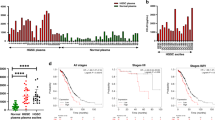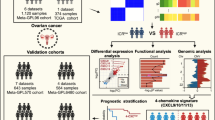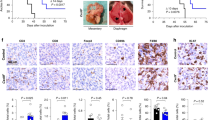Abstract
To understand the chemokine network in a tissue, both chemokine and chemokine receptor expression should be studied. Human epithelial ovarian tumours express a range of chemokines but little is known about the expression and localisation of chemokine receptors. With the aim of understanding chemokine action in this cancer, we investigated receptors for CC–chemokines and their ligands in 25 biopsies of human ovarian cancer. CC–chemokine receptor mRNA was generally absent from solid tumours, the exception being CCR1 which was detected in samples from 75% of patients. CCR1 mRNA localised to macrophages and lymphocytes and there was a correlation between numbers of CD8+ and CCR1 expressing cells (P = 0.031). mRNA for 6 CC-chemokines was expressed in a majority of tumour samples. In a monocytic cell line in vitro, we found that CCR1 mRNA expression was increased 5-fold by hypoxia. We suggest that the CC-chemokine network in ovarian cancer is controlled at the level of CC-chemokine receptors and this may account for the phenotypes of infiltrating cells found in these tumours. The leukocyte infiltrate may contribute to tumour growth and spread by providing growth survival factors and matrix metalloproteases. Thus, CCR1 may be a novel therapeutic target in ovarian cancer. © 2001 Cancer Research Campaign http://www.bjcancer.com
Similar content being viewed by others
Article PDF
Change history
16 November 2011
This paper was modified 12 months after initial publication to switch to Creative Commons licence terms, as noted at publication
References
Altman DG (1991). Practical statistics for medical research. Chapman and Hall: London
Baggiolini M and Moser B (1997) Blocking chemokine receptors. J Exp Med 186: 1189–1191
Bonecchi R, Polentarutti N, Luini W, Borsatti A, Bernasconi S, Locati M, Power C, Proudfoot A, Wells TNC, Mackay C, Mantovani A and Sozzani S (1999) Up-regulation of CCR1 and CCR3 and induction of chemotaxis to CC chemokines by IFN-gamma in human neutrophils. J Immunol 162: 474–479
Bottazzi B, Ghezzi P, Taraboletti G, Salmona M, Colombo N, Bonazzi C, Mangioni C and Mantovani A (1985) Tumor-derived chemotactic factor(s) from human ovarian carcinoma: evidence for a role in the regulation of macrophage content of neoplastic tissues. Int J Cancer 36: 167–173
Burke F, Relf M, Negus R and Balkwill F (1996) A cytokine profile of normal and malignant ovary. Cytokine 8: 578–585
Car BD, Meloni F, Luisetti M, Semenzato G, Gialdroni-Grassi G and Walz A (1994) Elevated IL-8 and MCP-1 in the bronchoalveolar lavage fluid of patients with idiopathic pulmonary fibrosis and pulmonary sarcoidosis. Am J Respir Crit Care Med 149: 655–659
Clore GM and Gronenborn AM (1995) Three-dimensional structures of alpha and beta chemokines. Faseb J 9: 57–62
Colantonio L, Iellem A, Clissi B, Pardi R, Rogge L, Sinigaglia F and Dambrosio D (1999) Upregulation of integrin alpha 6/beta 1 and chemokine receptor CCR1 by interleukin-12 promotes the migration of human type 1 helper T cells. Blood 94: 2981–2989
Ebnet K and Vestweber D (1999) Molecular mechanisms that control leukocyte extravasation: the selectins and the chemokines. Histochem Cell Biol 112: 1–23
Forsythe JA, Jiang BH, Iyer NV, Agani F, Leung SW, Koos RD and Semenza GL (1996) Activation of vascular endothelial growth factor gene transcription by hypoxia-inducible factor 1. Mol-Cell-Biol 16: 4604–4613
Gao JL, Wynn TA, Chang Y, Lee EJ, Broxmeyer HE, Cooper S, Tiffany HL, Westphal H, Kwon-Chung J and Murphy PM (1997) Impaired host defense, hematopoiesis, granulomatous inflammation and type 1-type 2 cytokine balance in mice lacking CC chemokine receptor 1. J Exp Med 185: 1959–1968
Gao W, Topham PS, King JA, Smiley ST, Csizmadia V, Lu B, Gerard CJ and Hancock WW (2000) Targeting of the chemokine receptor CCR1 suppresses development of acute and chronic cardiac allograft rejection. J Clin Invest 105: 35–44
Griffiths L, Binley K, Iqball S, Kan O, Maxwell P, Ratcliffe P, Lewis C, Harris A, Kingsman S and Naylor S (2000) The macrophage-a novel system to deliver gene therapy to pathological hypoxia. Gene Ther 7: 255–262
Grimshaw MJ and Balkwill FR (2001) Inhibition of monocyte and macrophage chemotaxis by hypoxia and inflammation-a potential mechanism. Eur J Immunol 31: 480–489
Grutkoski PS, Graeber CT, Damico R, Keeping H and Simms HH (1999) Regulation of IL-8RA (CXCR1) expression in polymorphonuclear leukocytes by hypoxia/reoxygenation. J Leukoc Biol 65: 171–178
Hockel M, Schlenger K, Hockel S, Aral B, Schaffer U and Vaupel P (1998) Tumor hypoxia in pelvic recurrences of cervical cancer. Int J Cancer 79: 365–369
Hosaka S, Akahoshi T, Wada C and Kondo H (1994) Expression of the chemokine superfamily in rheumatoid arthritis. Clin Exp Immunol 97: 451–457
Howard OMZ, Oppenheim JJ and Wang JM (1999) Chemokines as molecular targets for therapeutic intervention. J Clin Immunol 19: 280–292
Kurihara T, Warr G, Loy J and Bravo R (1997) Defects in macrophage recruitment and host defense in mice lacking the CCR2 chemokine receptor. J Exp Med 186: 1757–1762
Lu B, Rutledge BJ, Gu L Fiorillo J, Lukacs NW, Kunkel SL, North R, Gerard C and Rollins BJ (1998) Abnormalities in monocyte recruitment and cytokine expression in monocyte chemoattractant protein 1-deficient mice. J Exp Med 187: 601–608
Mantovani A (1994) Tumor-associated macrophages in neoplastic progression: a paradigm for the in vivo function of chemokines. Lab Invest 71: 5–16
Mantovani A, Bottazzi B, Colotta F, Sozzani S and Ruco L (1992) The origin and function of tumor-associated macrophages. Immunol Today 13: 265–270
Mantovani A, Allavena P, Vecchi A and Sozzani S (1998) Chemokines and chemokine receptors during activation and deactivation of monocytes and dendritic cells and in amplification of th1 versus th2 responses. Int J Clin Lab Res 28: 77–82
Mattei S, Colombo MP, Melani C, Silvani A, Parmiani G and Herlyn M (1994) Expression of cytokine/growth factors and their receptors in human melanoma and melanocytes. Int J Cancer 56: 853–857
Maxwell P and Ratcliffe P (1998) Regulation of expression of the erythropoietin gene. Curr Opin Hematol 5: 166–170
Naylor MS, Stamp GW and Balkwill FR (1990) Investigation of cytokine gene expression in human colorectal cancer. Cancer Res 50: 4436–4440
Naylor MS, Stamp GW, Foulkes WD, Eccles D and Balkwill FR (1993) Tumor necrosis factor and its receptors in human ovarian cancer. Potential role in disease progression. J Clin Invest 91: 2194–2206
Negus RP, Stamp GW, Relf MG, Burke F, Malik ST, Bernasconi S, Allavena P, Sozzani S, Mantovani A and Balkwill FR (1995) The detection and localization of monocyte chemoattractant protein-1 (MCP-1) in human ovarian cancer. Journal of Clinical Investigation 95: 2391–2396
Negus RP, Stamp GW, Hadley J and Balkwill FR (1997) Quantitative assessment of the leukocyte infiltrate in ovarian cancer and its relationship to the expression of C-C chemokines. Am J Pathol 150: 1723–1734
Negus RP, Turner L, Burke F and Balkwill FR (1998) Hypoxia down-regulates MCP-1 expression: implications for macrophage distribution in tumors. J Leukoc Biol 63: 758–765
Quandt K, Frech K, Karas H, Wingender E and Werner T (1995) Matlnd and MatInspector: new fast and versatile tools for detection of consensus matches in nucleotide sequence data. Nucleic Acids Res 23: 4878–4884
Schweickart VL, Epp A, Raport CJ and Gray PW (2000) CCR11 is a functional receptor for the monocyte chemoattractant protein family of chemokines. J Biol Chem 275: 9550–9556
Sica A, Saccani A, Borsatti A, Power CA, Wells TN, Luini W, Polentarutti N, Sozzani S and Mantovani A (1997) Bacterial lipopolysaccharide rapidly inhibits expression of C-C chemokine receptors in human monocytes. Journal of Experimental Medicine 185: 969–974
Sica A, Saccani A, Bottazzi B, Bernasconi S, Allavena P, Gaetano B, Fei F, LaRosa G, Scotton C, Balkwill F and Mantovani A (2000) Defective Expression of the Monocyte Chemotactic Protein-1 Receptor CCR2 in Macrophages Associated with Human Ovarian Carcinoma. J Immunol 164: 733–738
Signoret N, Rosenkilde MM, Klasse PJ, Schwartz TW, Malim MH, Hoxie JA and Marsh M (1998) Differential regulation of cxcr4 and ccr5 endocytosis. J Cell Sci 111: 2819–2830
Takeya M, Yoshimura T, Leonard EJ and Takahashi K (1993) Detection of monocyte chemoattractant protein-1 in human atherosclerotic lesions by an anti-monocyte chemoattractant protein-1 monoclonal antibody. Hum Pathol 24: 534–539
Turner L, Scotton C, Negus R and Balkwill F (1999) Hypoxia inhibits macrophage migration. Eur J Immunol 29: 2280–2287
Turner SJ, Domin J, Waterfield MD, Ward SG and Westwick J (1998) The CC chemokine monocyte chemotactic peptide-1 activates both the class I p85/p110 phosphatidylinositol 3-kinase and the class II P13K-C2alpha. J Biol Chem 273: 25987–25995
Van Coillie E, Froyen G, Nomiyama H, Miura R, Fiten P, Van Aelst I, Van Damme J and Opdenakker G (1997) Human monocyte chemotactic protein-2: cDNA cloning and regulated expression of mRNA in mesenchymal cells. Biochem Biophys Res Commun 231: 726–730
Vaupel P, Thews O, Kelleher DK and Hoeckel M (1998) Current status of knowledge and critical issues in tumor oxygenation. Results from 25 years research in tumor pathophysiology. Adv Exp Med Biol 454: 591–602
Wang JM, Deng XY, Gong WH and Su SB (1998) Chemokines and their role in tumor-growth and metastasis. J Immunol Methods 220: 1–17
Xu L, Xie K, Mukaida N, Matsushima K and Fidler IJ (1999) Hypoxia-induced elevation in interleukin-8 expression by human ovarian carcinoma cells. Cancer Res 59: 5822–5829
Yoong KF, Afford SC, Jones R, Aujla P, Qin S, Price K, Hubscher SG and Adams DH (1999) Expression and function of CXC and CC chemokines in human malignant liver tumors: a role for human monokine induced by gamma-interferon in lymphocyte recruitment to hepatocellular carcinoma. Hepatology 30: 100–111
Zella D, Barabitskaja O, Casareto L, Romerio F, Secchiero P, Reitz MS, Gallo RC and Weichold FF (1999) Recombinant IFN-alpha (2b) increases the expression of apoptosis receptor CD95 and chemokine receptors CCR1 and CCR3 in monocytoid cells. J Immunol 163: 3169–3175
Zlotnik A and Yoshie O (2000) Chemokines: A new classification system and their role in immunity. Immunity 12: 121–127
Author information
Authors and Affiliations
Rights and permissions
From twelve months after its original publication, this work is licensed under the Creative Commons Attribution-NonCommercial-Share Alike 3.0 Unported License. To view a copy of this license, visit http://creativecommons.org/licenses/by-nc-sa/3.0/
About this article
Cite this article
Scotton, C., Milliken, D., Wilson, J. et al. Analysis of CC chemokine and chemokine receptor expression in solid ovarian tumours. Br J Cancer 85, 891–897 (2001). https://doi.org/10.1054/bjoc.2001.2020
Received:
Revised:
Accepted:
Published:
Issue date:
DOI: https://doi.org/10.1054/bjoc.2001.2020
Keywords
This article is cited by
-
Evolving notions on immune response in colorectal cancer and their implications for biomarker development
Inflammation Research (2018)
-
Pre-operative neutrophil count and neutrophil-lymphocyte count ratio (NLCR) in predicting the histological grade of paediatric brain tumours: a preliminary study
Acta Neurochirurgica (2018)
-
CCL15/CCR1 axis is involved in hepatocellular carcinoma cells migration and invasion
Tumor Biology (2016)
-
Cancer-Related Inflammation
Journal of Clinical Immunology (2013)
-
Role of Bone Marrow-Derived Cells in Angiogenesis: Focus on Macrophages and Pericytes
Cancer Microenvironment (2012)



